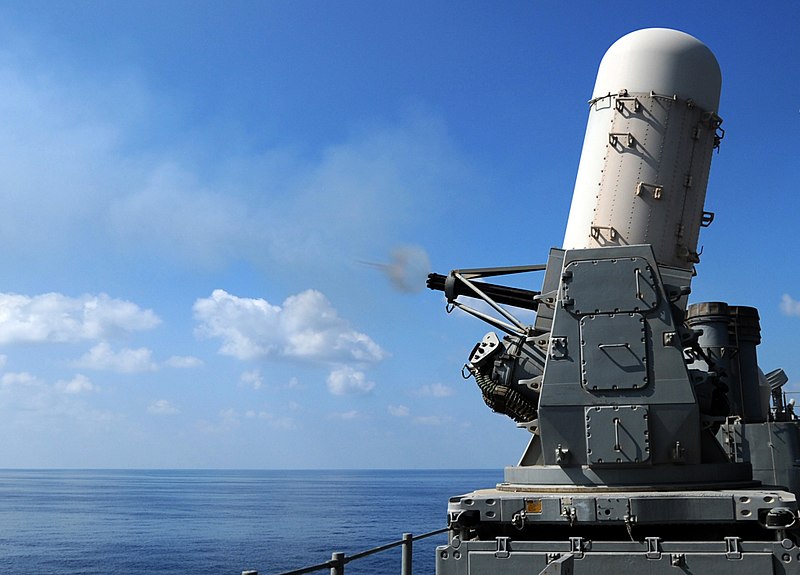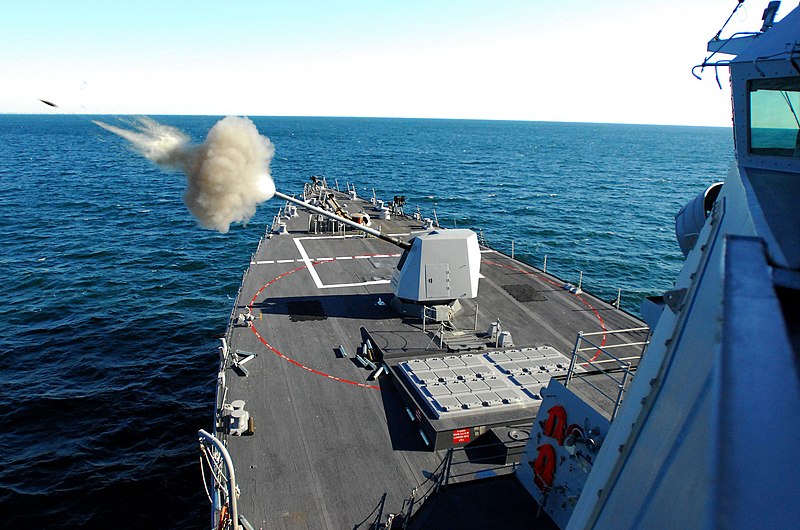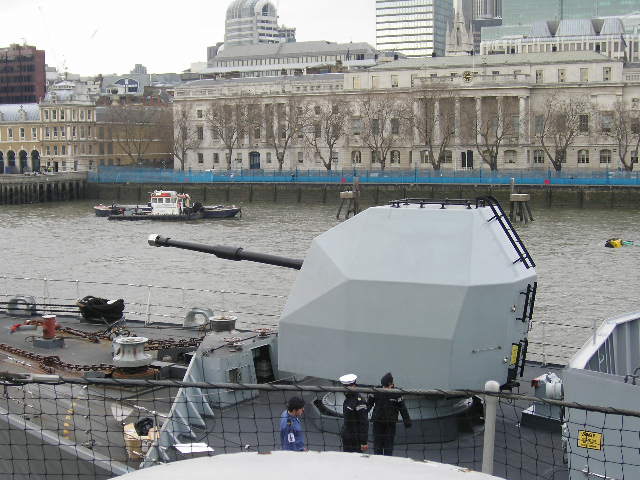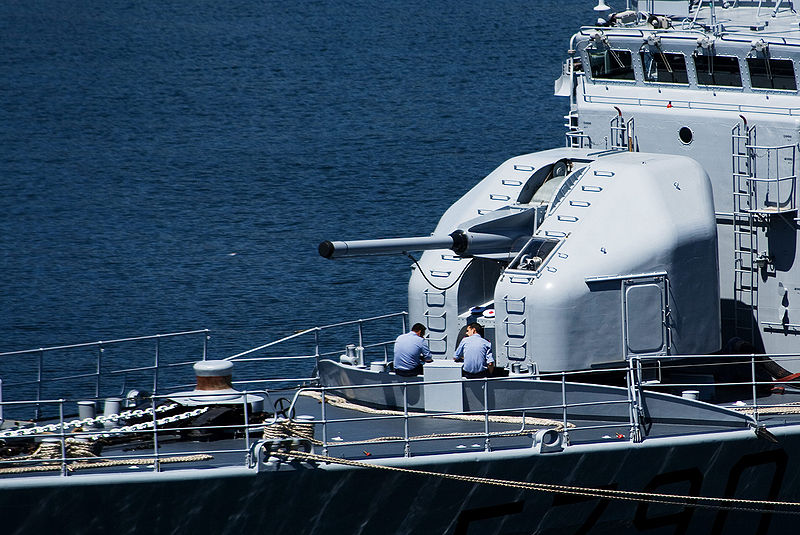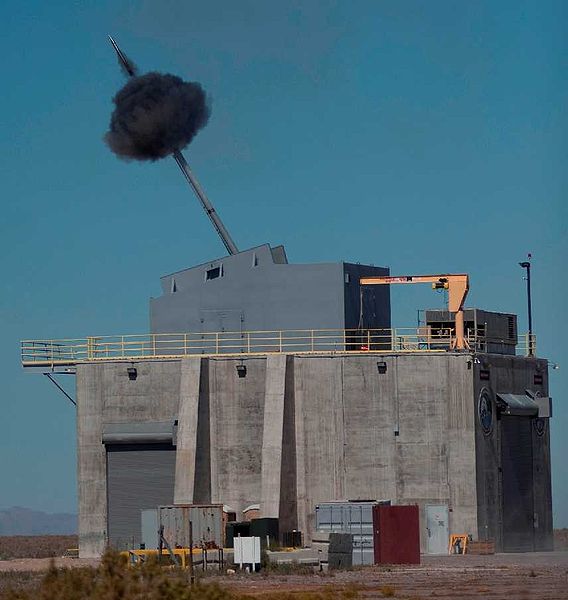Naval Guns
The general mission of naval fire support is to destroy, neutralize, or suppress enemy targets that oppose our forces. Naval fire support may be provided by naval gunfire and naval air power. Usually, it is delivered in concert with supporting fires from other arms.
The fire support system is made up of three distinct components that function together to give the commander the fire support he needs to accomplish his mission. These three components are as follows:
Command, control, and communications (C3) systems, facilities, and personnel required to manage fire support and to direct those tactical and technical/ actions needed to attack targets quickly and effectively.
Target acquisition systems needed to acquire targets by reconnaissance, surveillance, and devices. These systems include many individuals, units, and resources on the battlefield that help detect the to enemy.
Weapons and ammunition to deliver the firepower on the target according to the commander's battle plan.
The key to effective fire support is the force commander's ability to bring these assets to bear on the enemy in an integrated and coordinated manner.
Since 1992, when it retired the last of its battleships, the Navy's surface fire support capabilities have been limited to 5-inch/54 caliber guns and munitions that lack adequate range, accuracy, and lethality. Targeting and fire control are still done manually, and the Navy acknowledges that the communications links between fire support ships and their customers are inadequate. A growing threat from sea-skimming antiship missiles is forcing fire support ships to operate at ever increasing ranges from shore, further limiting the utility of existing guns.
The Navy plans to address its surface fire support capability deficiencies in two phases, near- (scheduled completion by fiscal year 2001) and long-term (time frame still being defined). During the near-term phase, the Navy is developing (1) a modified version of the 5-inch gun currently used on surface combatant ships, (2) an extended range guided 5-inch munition, and (3) a shipboard surface fire support warfare control system consisting of computer resources and communication interfaces designed to automate battle management functions.
The variety of projectiles, powder charges, and fuzes permits selection of optimum combinations for the attack of targets. Fuzes, for example, can be set to provide for air, surface, or subsurface detonation of rounds. The high muzzle velocity and relatively flat trajectory of the naval gun make it suitable for direct fire or assault fire, particularly against materiel targets that must be penetrated or destroyed and that present a vertical face. The large volume of fire that can be delivered in a relatively short time is a distinct advantage in delivering neutralization fires. For example, the 5-inch/54-caliber gun has a rate of fire of 35 rounds per minute at the maximum rate and 20 rounds per minute at the sustained rate. The normal dispersion pattern is narrow in deflection and long in range. Very close supporting fire can be delivered when the GT line is parallel to the front line. This pattern also permits effective coverage of such targets as roads and runways when the GT line coincides with the long axis of the target.
The relatively flat trajectory of naval gunfire results in a large range probable error. Therefore, the dispersion pattern of the naval gun is roughly elliptical, with the long axis in the direction of fire. Before selecting naval gunfire as the proper fire support means, the FSCOORD must consider the GT line and its relation to the forward line of own troops (FLOT). The hydrographic conditions of the sea area in which the naval gunfire ship must operate may be unfavorable. It may cause undesirable firing positions or require firing at longer ranges. The accuracy of naval gunfire depends on the accuracy with which the position of the firing ship has been fixed. Navigational aids, prominent terrain features, or radar beacons emplaced on the shore may be used to compensate for this limitation. Bad weather and poor visibility make it difficult to determine the position of the ship by visual means and reduce the observer's opportunities for locating targets and adjusting fires. Bad weather also might force the ship out to sea. If the ship is firing while under way, the line of fire in relation to the frontline may change. This could require cancellation of the fire mission, because the inherent large range probable errors may endanger friendly forces.
The sole means of between ship and shore is radio. Normally, several nets are established to control and coordinate the support. Radio communications can be interrupted by equipment limitations, enemy EW, and unfavorable atmospheric conditions.
If the naval gunfire ship comes under enemy surface, subsurface, and/or air attack, the ship may cancel its fire mission with the ground forces and try to counter this threat. The shore bombardment allowance varies with the ship type (600 to 1,800 rounds). When the need arises, remaining rounds will be held for self-defense of the ship. The first priority of the ship is self-preservation. The ship will interrupt its support mission if its survival is threatened. This includes ammunition expenditure. Since naval guns are, in addition to shore bombardment, used for ship or fleet defense, the ship will keep a large percentage of its magazine capacity for this contingency.
When naval fire support is available and the general tactical situation permits its use, naval firepower can provide large volumes of devastating, immediately available, and instantly responsive fire support to combat forces operating near coastal waters. These fires may be in support of amphibious operations within range of naval aircraft and gunfire, but they also may be made available to support land operations.
Naval gunfire ships are assigned one of two missions - direct support or general support. Relationships between assigned ships and supported ground force units are based on limited, delegated responsibility. For example, a ship placed in support provides the requested fire within its capability, but ship positioning and method of delivery are at the discretion of the ship captain. The supported ground force unit selects the targets, the timing of fires on the targets, and the adjustment of fires.
A ship in direct support (IX) of a specific troop unit delivers both planned and call fires. Call fires are to the ship what targets of opportunity are to artillery units. A naval gunfire spotter with the supported unit conducts and adjusts call fires. Call fires also may be adjusted by a naval gunfire air spotter. Members of the air and naval gunfire liaison company (ANGLICO) are specially trained in conducting naval gunfire. However, the procedures are simplified and standardized so that any trained supporting arms observer can effectively adjust the fire of a ship. Naval gunfire (NGF) DS is not the same as field artillery (FA) DS. A direct support ship will respond to calls for fire from units other than the supported unit when ordered to do so by the fire support group commander, the division naval gunfire officer, or the brigade NGLO.
General support (GS) missions are assigned to ships supporting units of brigade size or larger. The normal procedure is for the fires of the GS ship to be adjusted by an aerial observer or for the liaison officer (LO) to assign the fires of the ship to a battalion spotter for fire missions. In the latter case, on completion of the mission, the ship reverts to general support. Prearranged fires are delivered in accordance with a schedule of fire
ANGLICO personnel are available to advise unit commanders from company through division levels on how to best use the naval air and gunfire support available to them. Liaison personnel can give unit commanders and FSCOORDs information on weapon ranges, ammunition effects, all-weather bombing capabilities, and landing zone requirements.
The only US NGF weapon system available now is the 5-inch/54 found primarily on destroyers.








